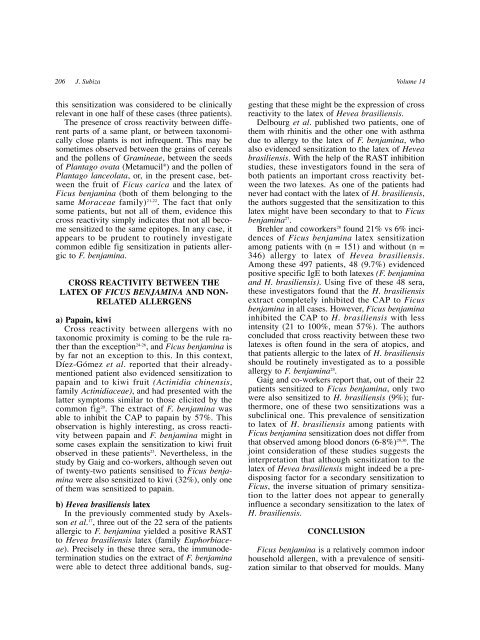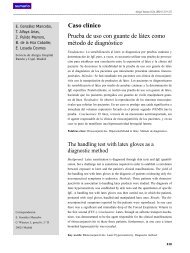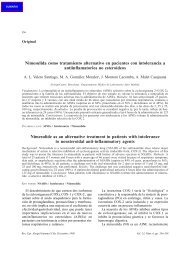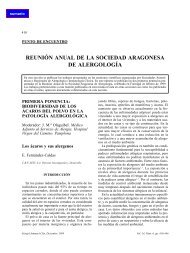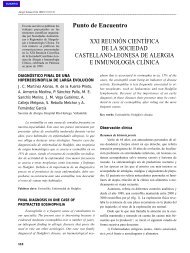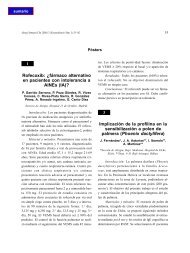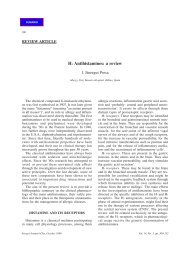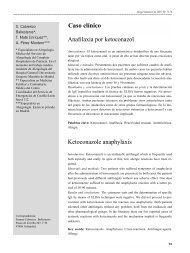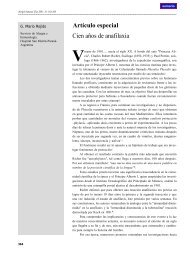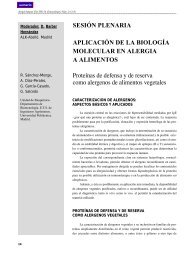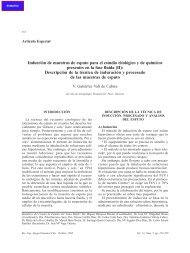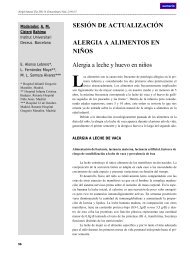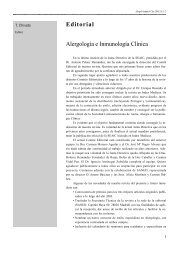Ficus benjamina, a new source of household environmental allergens
Ficus benjamina, a new source of household environmental allergens
Ficus benjamina, a new source of household environmental allergens
You also want an ePaper? Increase the reach of your titles
YUMPU automatically turns print PDFs into web optimized ePapers that Google loves.
206 J. Subiza Volume 14<br />
this sensitization was considered to be clinically<br />
relevant in one half <strong>of</strong> these cases (three patients).<br />
The presence <strong>of</strong> cross reactivity between different<br />
parts <strong>of</strong> a same plant, or between taxonomically<br />
close plants is not infrequent. This may be<br />
sometimes observed between the grains <strong>of</strong> cereals<br />
and the pollens <strong>of</strong> Gramineae, between the seeds<br />
<strong>of</strong> Plantago ovata (Metamucil ¨ ) and the pollen <strong>of</strong><br />
Plantago lanceolata, or, in the present case, between<br />
the fruit <strong>of</strong> <strong>Ficus</strong> carica and the latex <strong>of</strong><br />
<strong>Ficus</strong> <strong>benjamina</strong> (both <strong>of</strong> them belonging to the<br />
same Moraceae family) 21,22 . The fact that only<br />
some patients, but not all <strong>of</strong> them, evidence this<br />
cross reactivity simply indicates that not all become<br />
sensitized to the same epitopes. In any case, it<br />
appears to be prudent to routinely investigate<br />
common edible fig sensitization in patients allergic<br />
to F. <strong>benjamina</strong>.<br />
CROSS REACTIVITY BETWEEN THE<br />
LATEX OF FICUS BENJAMINA AND NON-<br />
RELATED ALLERGENS<br />
a) Papain, kiwi<br />
Cross reactivity between <strong>allergens</strong> with no<br />
taxonomic proximity is coming to be the rule rather<br />
than the exception 24-26 , and <strong>Ficus</strong> <strong>benjamina</strong> is<br />
by far not an exception to this. In this context,<br />
D’ez-G—mez et al. reported that their alreadymentioned<br />
patient also evidenced sensitization to<br />
papain and to kiwi fruit (Actinidia chinensis,<br />
family Actinidiaceae), and had presented with the<br />
latter symptoms similar to those elicited by the<br />
common fig 20 . The extract <strong>of</strong> F. <strong>benjamina</strong> was<br />
able to inhibit the CAP to papain by 57%. This<br />
observation is highly interesting, as cross reactivity<br />
between papain and F. <strong>benjamina</strong> might in<br />
some cases explain the sensitization to kiwi fruit<br />
observed in these patients 23 . Nevertheless, in the<br />
study by Gaig and co-workers, although seven out<br />
<strong>of</strong> twenty-two patients sensitised to <strong>Ficus</strong> <strong>benjamina</strong><br />
were also sensitized to kiwi (32%), only one<br />
<strong>of</strong> them was sensitized to papain.<br />
b) Hevea brasiliensis latex<br />
In the previously commented study by Axelsson<br />
et al. 17 , three out <strong>of</strong> the 22 sera <strong>of</strong> the patients<br />
allergic to F. <strong>benjamina</strong> yielded a positive RAST<br />
to Hevea brasiliensis latex (family Euphorbiaceae).<br />
Precisely in these three sera, the immunodetermination<br />
studies on the extract <strong>of</strong> F. <strong>benjamina</strong><br />
were able to detect three additional bands, sug-<br />
gesting that these might be the expression <strong>of</strong> cross<br />
reactivity to the latex <strong>of</strong> Hevea brasiliensis.<br />
Delbourg et al. published two patients, one <strong>of</strong><br />
them with rhinitis and the other one with asthma<br />
due to allergy to the latex <strong>of</strong> F. <strong>benjamina</strong>, who<br />
also evidenced sensitization to the latex <strong>of</strong> Hevea<br />
brasiliensis. With the help <strong>of</strong> the RAST inhibition<br />
studies, these investigators found in the sera <strong>of</strong><br />
both patients an important cross reactivity between<br />
the two latexes. As one <strong>of</strong> the patients had<br />
never had contact with the latex <strong>of</strong> H. brasiliensis,<br />
the authors suggested that the sensitization to this<br />
latex might have been secondary to that to <strong>Ficus</strong><br />
<strong>benjamina</strong> 27 .<br />
Brehler and coworkers 28 found 21% vs 6% incidences<br />
<strong>of</strong> <strong>Ficus</strong> <strong>benjamina</strong> latex sensitization<br />
among patients with (n = 151) and without (n =<br />
346) allergy to latex <strong>of</strong> Hevea brasiliensis.<br />
Among these 497 patients, 48 (9.7%) evidenced<br />
positive specific IgE to both latexes (F. <strong>benjamina</strong><br />
and H. brasiliensis). Using five <strong>of</strong> these 48 sera,<br />
these investigators found that the H. brasiliensis<br />
extract completely inhibited the CAP to <strong>Ficus</strong><br />
<strong>benjamina</strong> in all cases. However, <strong>Ficus</strong> <strong>benjamina</strong><br />
inhibited the CAP to H. brasiliensis with less<br />
intensity (21 to 100%, mean 57%). The authors<br />
concluded that cross reactivity between these two<br />
latexes is <strong>of</strong>ten found in the sera <strong>of</strong> atopics, and<br />
that patients allergic to the latex <strong>of</strong> H. brasiliensis<br />
should be routinely investigated as to a possible<br />
allergy to F. <strong>benjamina</strong> 28 .<br />
Gaig and co-workers report that, out <strong>of</strong> their 22<br />
patients sensitized to <strong>Ficus</strong> <strong>benjamina</strong>, only two<br />
were also sensitized to H. brasiliensis (9%); furthermore,<br />
one <strong>of</strong> these two sensitizations was a<br />
subclinical one. This prevalence <strong>of</strong> sensitization<br />
to latex <strong>of</strong> H. brasiliensis among patients with<br />
<strong>Ficus</strong> <strong>benjamina</strong> sensitization does not differ from<br />
that observed among blood donors (6-8%) 29,30 . The<br />
joint consideration <strong>of</strong> these studies suggests the<br />
interpretation that although sensitization to the<br />
latex <strong>of</strong> Hevea brasiliensis might indeed be a predisposing<br />
factor for a secondary sensitization to<br />
<strong>Ficus</strong>, the inverse situation <strong>of</strong> primary sensitization<br />
to the latter does not appear to generally<br />
influence a secondary sensitization to the latex <strong>of</strong><br />
H. brasiliensis.<br />
CONCLUSION<br />
<strong>Ficus</strong> <strong>benjamina</strong> is a relatively common indoor<br />
<strong>household</strong> allergen, with a prevalence <strong>of</strong> sensitization<br />
similar to that observed for moulds. Many


